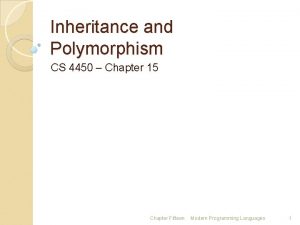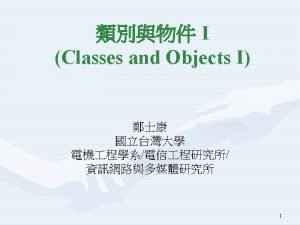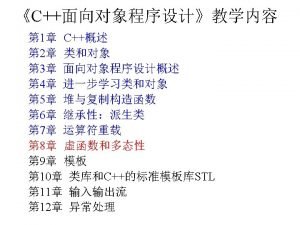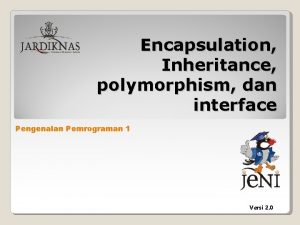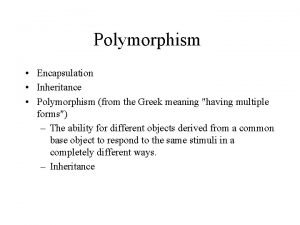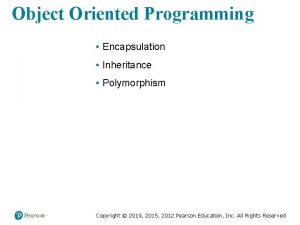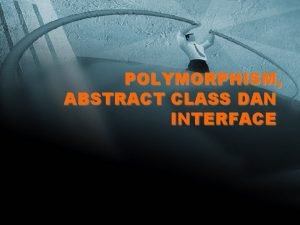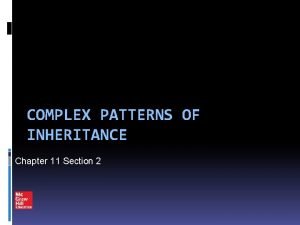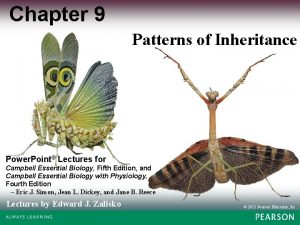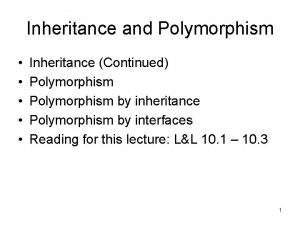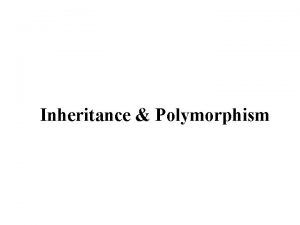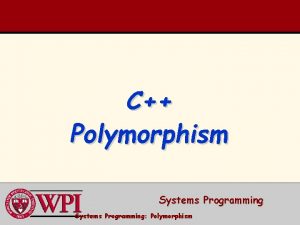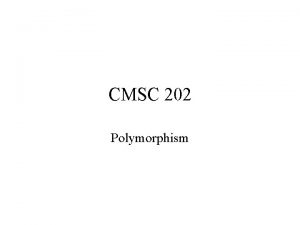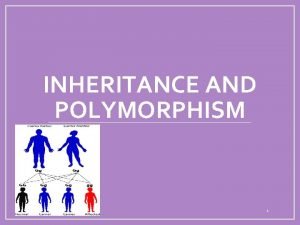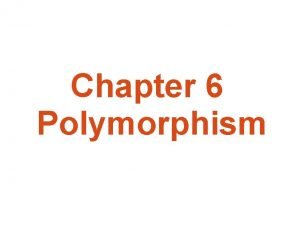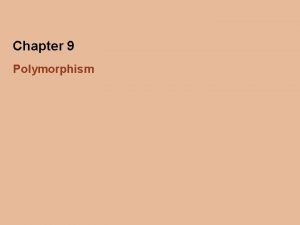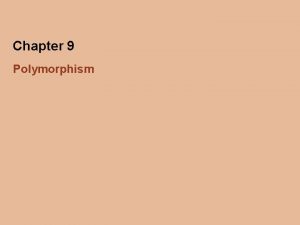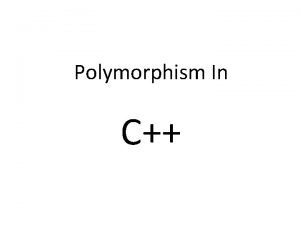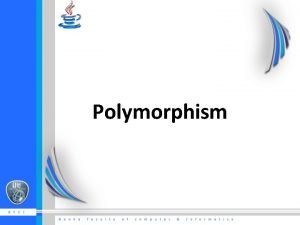Inheritance and Polymorphism CS 4450 Chapter 15 Chapter















- Slides: 15

Inheritance and Polymorphism CS 4450 – Chapter 15 Chapter Fifteen Modern Programming Languages 1

Subtype Polymorphism Person x; �Does this declare x to be a reference to an object of the Person class? �Not exactly—the type Person may include references to objects of other classes �Java, C#, C++, Python, D all support subtype polymorphism Chapter Fifteen Modern Programming Languages 2

Interfaces �A method prototype just gives the method name and type—no method body �An interface in Java or C# is a collection of method prototypes public interface Drawable { void show(int x. Pos, int y. Pos); void hide(); } Chapter Fifteen Modern Programming Languages 3

Why Use Interfaces? �An interface can be implemented by many (unrelated) classes: public class Window implements Drawable … public class Mouse. Pointer implements Drawable … public class Oval implements Drawable … �Interface name can be used as a reference type: Drawable d; d = new Icon("i 1. gif"); d. show(0, 0); d = new Oval(20, 30); d. show(0, 0); Chapter Fifteen Modern Programming Languages 4

Interface Semantics �A commitment to implement a contract �No implementation is inherited �Disadvantage: ◦ No code sharing �Advantage: ◦ No code commitment ◦ Freedom to implement any way you want Chapter Fifteen Modern Programming Languages 5

Extending Interfaces �An interface can extend another one �The result is the union of all the declared methods (in Java, not quite in C++) interface Persistent. Stack extends Stack, Persistent {} class Dynamic. Stack implements Persistent. Stack {…} Chapter Fifteen Modern Programming Languages 6

Implementation Inheritance �When a subclass extends its superclass, it inherits all its methods and fields ◦ A lesser degree of separation of interface from implementation �(Nothing like this happens with interfaces— when a class implements an interface, all it gets is an obligation) �In addition to inheritance, you also get subtype polymorphism Chapter Fifteen Modern Programming Languages 7

public class Icon { public class Label { private int x, y; private int width; private int height; private Gif image; private String text; public void move (int new. X, int new. Y) { { x = new. X; y = new. Y; } } public Gif get. Image() public String get. Text() { { return image; return text; } } Two classes with a lot in common—but neither is a simple extension of the other. Chapter Fifteen Modern Programming Languages 8

public abstract class Graphic { protected int x, y; protected int width, height; public void move(int new. X, int new. Y) { x = new. X; y = new. Y; } } public class Icon public class Label extends Graphic { private Gif image; private String text; public Gif get. Image() public String get. Text() { { return image; return text; } } Common code and data have been factored out into a common base class (which usually should be declared abstract). Chapter Fifteen Modern Programming Languages 9

Multiple Inheritance �In some languages (such as C++, Python Eiffel) a class can have more than one base class �Seems simple at first: just inherit fields and methods from all the base classes �For example: a multifunction printer Chapter Fifteen Modern Programming Languages 10

Collision Problem �The different base classes are unrelated, and may not have been designed to be combined �Scanner and Fax might both have a method named transmit �When Multi. Function. transmit is called, what should happen? Chapter Fifteen Modern Programming Languages 11

Diamond Problem �A class may inherit from the same base class through more than one path �If A defines a field x, then B has one and so does C �Does D get two of them? Chapter Fifteen Modern Programming Languages 12

Solvable, But… �A language that supports multiple inheritance must have mechanisms for handling these problems �Is the additional power worth the additional language complexity? �Designers of Java, C#, and D did not think so �Python has a simpler approach Chapter Fifteen Modern Programming Languages 13

Explicit Forwarding Simulating MI public class Multi. Function { private Printer my. Printer; private Copier my. Copier; private Scanner my. Scanner; private Fax my. Fax; public void copy() { my. Copier. copy(); } public void transmit. Scanned() { my. Scanner. transmit(); } public void send. Fax() { my. Fax. transmit(); } … } Chapter Fifteen Modern Programming Languages 14

Python MI Solution �When resolving the binding of an identifier: ◦ 1) Look first in the object itself ◦ 2) Then in its class ◦ 3) Then in all base classes in declaration order ◦ 4) Repeat 3 recursively as needed �Order of declaration of base classes matters! Chapter Fifteen Modern Programming Languages 15
 Subtype polymorphism
Subtype polymorphism Ic code
Ic code Oop polymorphism inheritance encapsulation
Oop polymorphism inheritance encapsulation Encapsulation inheritance polymorphism
Encapsulation inheritance polymorphism Encapsulation inheritance polymorphism
Encapsulation inheritance polymorphism Abstraction encapsulation inheritance polymorphism
Abstraction encapsulation inheritance polymorphism Polimorfisme pemrograman adalah
Polimorfisme pemrograman adalah Chapter 11 complex inheritance and human heredity test
Chapter 11 complex inheritance and human heredity test What is the difference between allotropy and polymorphism
What is the difference between allotropy and polymorphism Transition and transversion
Transition and transversion Chapter 11 section 2: complex patterns of inheritance
Chapter 11 section 2: complex patterns of inheritance Chapter 16 the molecular basis of inheritance
Chapter 16 the molecular basis of inheritance Chapter 15 the chromosomal basis of inheritance
Chapter 15 the chromosomal basis of inheritance A gene locus is
A gene locus is Chapter 16 molecular basis of inheritance
Chapter 16 molecular basis of inheritance Chapter 15 the chromosomal basis of inheritance
Chapter 15 the chromosomal basis of inheritance
